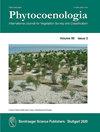亚平宁山脉北部(意大利北部)的Nardus富群落:植物社会学、生态学和植物地理学研究
IF 0.9
4区 生物学
Q4 ECOLOGY
引用次数: 18
摘要
以狭水杨为主的次生草地是一种广泛分布于欧洲低地到山地的人为植被类型。这些社区最近已被欧洲共同体确认为优先关心的生境。该研究的目的是对亚平宁山脉北部的这种植被进行详细和完整的植物社会学审查。进一步的目标是发现控制这些群落内植物区系变化的因素,并分析从北阿尔卑斯山到南亚平宁山脉的纳德斯草原沿纬度梯度的变化。我们对来自亚平宁山脉北部的134个植物社会学相关数据进行了聚类分析,该分析基于Kendall的tau不相似性度量。结果表明,红草属草地存在两种不同的群落(Carlino caulescentis-Nardetum strictae和Violo ferrarinis - nardetum strictae)。通过冗余分析,分析了植物区系组成与环境变量之间的关系。生境因子矩阵包括地形变量和由Ellenberg指标值导出的变量。海拔是解释植物区系变异的主要因素。通过对阿尔卑斯山脉、喀尔巴阡山脉和亚平宁山脉44个天气表的比较,通过NMDS排序,我们发现沿纬度梯度有两个主要的植物地理和生态阈值。本文章由计算机程序翻译,如有差异,请以英文原文为准。
The Nardus -rich communities in the northern Apennines (N-Italy): a phytosociological, ecological and phytogeographical study
Secondary grasslands dominated by Nardus stricta are an anthropogenic vegetation type that occurs widely through the Europe from lowlands to mountains. These communities have been recently recognized by the European Community as a habitat of priority interest. The aim of the study is to perform a detailed and complete phytosociological scrutiny of this vegetation in the northern Apennines. Further aims are to detect the factors controlling the floristic variation within these communities and to analyse the variations of Nardus grasslands along a latitudinal gradient from the northern Alps to the southern Apennines. We processed a set of 134 phytosociological releves from the northern Apennines through a cluster analysis based on Kendall’s tau dissimilarity measure. Results showed the occurrence of two different associations of Nardus grasslands (Carlino caulescentis-Nardetum strictae and Violo ferrarinii-Nardetum strictae). Relations between their floristic composition and environmental variables were detected through Redundancy Analysis. The matrix of habitat factors included topographic variables and variables derived from Ellenberg’s indicator values. Elevation was the factor explaining most of the floristic variation. From the comparison of 44 synoptic tables from the Alps, Carpathians and Apennines, processed through a NMDS ordination, we detected two main phytogeographic and ecological thresholds along the latitudinal gradient.
求助全文
通过发布文献求助,成功后即可免费获取论文全文。
去求助
来源期刊

Phytocoenologia
生物-植物科学
CiteScore
2.60
自引率
0.00%
发文量
7
审稿时长
>12 weeks
期刊介绍:
Phytocoenologia is an international, peer-reviewed journal of plant community ecology. It is devoted to vegetation survey and classification at any organizational and spatial scale and without restriction to certain methodological approaches. The journal publishes original papers that develop new vegetation typologies as well as applied studies that use such typologies, for example, in vegetation mapping, ecosystem modelling, nature conservation, land use management or monitoring. Particularly encouraged are methodological studies that design and compare tools for vegetation classification and mapping, such as algorithms, databases and nomenclatural principles. Papers dealing with conceptual and theoretical bases of vegetation survey and classification are also welcome. While large-scale studies are preferred, regional studies will be considered when filling important knowledge gaps or presenting new methods.
 求助内容:
求助内容: 应助结果提醒方式:
应助结果提醒方式:


